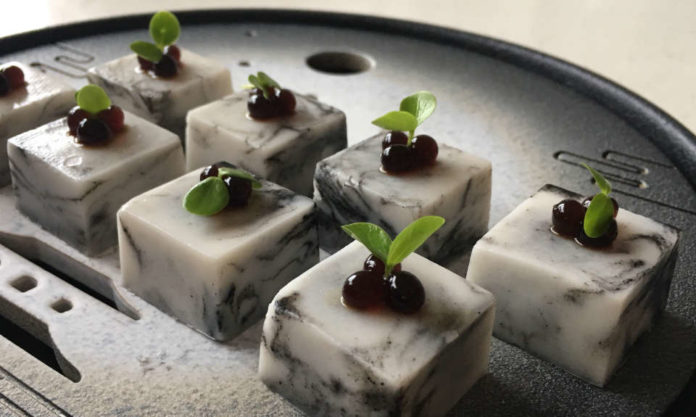The inspiration for this month’s column was served up to me on a plate; eight slabs of polished black and white marble. Except the edible kind of marble, the kind made from taro; slightly sweet with a gentle wobble and not the least bit heavy. Everyday cooking? Certainly not, but a suitably dazzling start to this year’s “nian ye fan”, or New Year meal.
The idea of making something so beautiful, a work of art, out of a material that is ultimately destined for digestion is an interesting one. It highlights the fact that as humans, we like things that look nice. Eye-popping edibles can be found the world over in high-end restaurants and casual eateries, even at home, but in China the visual appeal is deeply set in its cuisine.
In Chinese cooking, “se” (色; colour), “xiang” (香; aroma), “wei” (味; flavour) and “xing” (形; form) make up the four pillars of any good dish. As the Chinese-trained British cookery writer, Fuchsia Dunlop, puts it, “A fine dish will first assail to the eyes with its beauty, then the nose with its scent; the tongue is the next to be delighted, along with the inside of the mouth”. Two out of four qualities refer to aesthetic appeal alone, but they must exist in equal balance to smell and taste.
- A Royal Success; The Largest Exhibition of Chinese Art Ever
- China Design Icons 101; A Lowdown on Chinese Logos
- When Art History Goes into the Washing Machine
One need not look further than an average Chinese menu to appreciate the importance of visual appeal. Those glossy, bible-thick volumes don’t half get the saliva glands going, unlike the text-heavy equivalents that is the tendency in the West. What arrives at the table may not match the picture, but the attention to aesthetic is there.
Take note for example, the next time you are at a bog-standard canteen, how the colour of each dish is carefully thought out. Stir-fried slices of green lettuce root are made especially vibrant by a scattering of bright red pepper.
For breakfast, snow fungus, lotus seeds and lily bulbs, all white, are combined in a soup with one or two dark crimson dates or red goji berries for contrast. As for form; cubes match cubes, slivers match slivers. Different ingredients cut into uniform shapes not only cook at the same speed, but they are attractive too.
- In Perspective; Sifang Art Museum
- Good Coppers; Nanjing’s Best Bronzes
- Five Steps to Fudging with Finesse
Buddhist monasteries around China go to great lengths to entertain their guests with lavish and decorative banquets, serving food that is quite the opposite of their usual modest meals. Doufu and other plant-based ingredients are fashioned into pseudo meats and seafood of all varieties. One might have “spare ribs” made from wheat gluten on a bamboo shoot “bone”, or deep-fried “fish” made from potato and doufu skin. The imagination and artistry are impressive.
For many Chinese however, meat is the Holy Grail, and what could be better proof of that fact than the meat shaped stone at the Palace Museum in Taipei, which is one of the museum’s most popular exhibits? The Qing Dynasty, carved quartz resembles a sizable chunk of red, braised pork belly, complete with translucent skin. It even sits upon a carved wooden mount.
And so we’ve come full circle, from enticing cubes of edible marble to the less edible, yet equally alluring meat, shaped stone. Whether it’s food that’s art or art that’s food, it is clear that both occupy a special, shared place in China’s heart.









